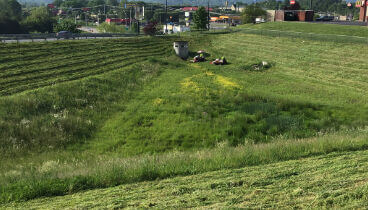A stormwater management system is a basic and required feature of every commercial, industrial, or distribution center property. Whether the stormwater management system employs a dry or a wet pond or some other kind of system, the goal is to keep your property’s runoff from polluting adjacent properties and to remove pollutants from impermeable and semi-impermeable areas like parking lots and certain areas around the property.
 Stormwater, in general, is runoff from rain or snowmelt and it has a significant influence on the condition of our waterways. Stormwater washes across ground surfaces after a precipitation event and accumulates whatever is on them, such as sediments, excessive nutrients, pollutants, microorganisms, and so on. These harmful compounds dissolve and are transported by stormwater.
Stormwater, in general, is runoff from rain or snowmelt and it has a significant influence on the condition of our waterways. Stormwater washes across ground surfaces after a precipitation event and accumulates whatever is on them, such as sediments, excessive nutrients, pollutants, microorganisms, and so on. These harmful compounds dissolve and are transported by stormwater.
In an undisturbed, natural ecosystem, the polluted water is cleaned before it reaches the waterways in regions with natural ground cover, such as grasslands or forests. The soil works as a giant water filter, soaking up polluted rainwater and filtering out toxins before it enters groundwater or other surface waterways such as creeks and rivers. This, however, is not the case when an ecosystem is disturbed by urban development like the construction of a commercial property. This is why there are mandatory programs in place like the Clean Water Act of 1972 and National Pollutant Discharge Elimination System (NPDES) permit programs.
In general, the stormwater management system is low-maintenance and simple to overlook. As it turns out, ignoring it might lead to costly difficulties. Here are some of the most prevalent issues we deal with in stormwater management.
Flooding
When a property floods after a storm, the most probable cause is a malfunctioning stormwater management system. Flooding often occurs initially in a parking lot area, but it may also affect buildings and adjoining properties if the flooding is severe. A flooded parking lot may result in hydroplaning and property damage, as well as the inability to utilize the lot under stormy weather conditions. Flooding in buildings and on adjoining properties is a significant liability that may result in property damage as well as costly legal fees and fines.
 A visual assessment of the stormwater system and the removal of any obstructions are generally sufficient to address stormwater flooding. Stormwater flooding may be prevented by following these steps: During the inspection, a skilled stormwater management specialist will check the storm drains that transport water from the parking lot to the stormwater management system. They’ll also look at the pond’s outlets. Typically, cleaning any obstructions will clear typical issues; but, if it is discovered that the pipe is deteriorating, an engineering solution will be necessary in certain cases.
A visual assessment of the stormwater system and the removal of any obstructions are generally sufficient to address stormwater flooding. Stormwater flooding may be prevented by following these steps: During the inspection, a skilled stormwater management specialist will check the storm drains that transport water from the parking lot to the stormwater management system. They’ll also look at the pond’s outlets. Typically, cleaning any obstructions will clear typical issues; but, if it is discovered that the pipe is deteriorating, an engineering solution will be necessary in certain cases.
Distress to the parking lot itself might sometimes be the source of the problem. When parking lot pavement is installed, it is structured to guide runoff away from the lot and into the stormwater management system. Water might be draining in the wrong direction due to buckling and shifting pavement, leading to flooding and erosion.
 Dry ponds work by enabling water to soak quickly through the soil, allowing toxins to be filtered out. Heavy vegetative growth can reduce the soil’s capacity to percolate by replacing sand and loam with roots, reducing the soil’s ability to absorb excess stormwater. Flooding and the entry of unfiltered water onto adjoining properties can have inevitable consequences, which may result in legal action and/or additional costs.
Dry ponds work by enabling water to soak quickly through the soil, allowing toxins to be filtered out. Heavy vegetative growth can reduce the soil’s capacity to percolate by replacing sand and loam with roots, reducing the soil’s ability to absorb excess stormwater. Flooding and the entry of unfiltered water onto adjoining properties can have inevitable consequences, which may result in legal action and/or additional costs.  Stormwater pond embankments may deteriorate and fail if they are not properly planned or maintained. If erosion is identified early enough, it may be controlled relatively affordably using straw bales, netting, and plants. If erosion is allowed to continue, however, it has the potential to cause the whole system to collapse, resulting in floods and other issues, as well as costly repairs. The most effective and cost-efficient option is to inspect the pond on a regular basis for symptoms of erosion and deal with them as soon as possible.
Stormwater pond embankments may deteriorate and fail if they are not properly planned or maintained. If erosion is identified early enough, it may be controlled relatively affordably using straw bales, netting, and plants. If erosion is allowed to continue, however, it has the potential to cause the whole system to collapse, resulting in floods and other issues, as well as costly repairs. The most effective and cost-efficient option is to inspect the pond on a regular basis for symptoms of erosion and deal with them as soon as possible.